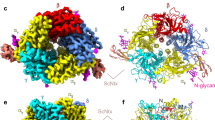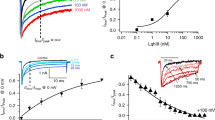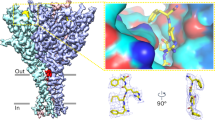Abstract
DETAILED elucidation of the molecular organisation which controls ionic flow through the excitable membranes has been prevented by a difficulty in isolating substances to which characteristic features of the ionic channels can be attributed1–3. In the study of the cholinergic receptor, polypeptide α-toxins from certain snakes have been successfully used for the identification and purification of nicotinic receptors4. Thus, agents analogous to snake toxins may be of a decisive value in the molecular approach to ionic channels, and toxins from certain scorpions are among the most promising candidates5–8. Scorpion toxins seem to act by modifying kinetic properties of Na channels as well as by suppressing the current through K channels9–11. But, no quantitative analysis was made on an electrophysiological basis to show the precise nature of the toxin-binding. We describe here a study of the effects of a toxin from Leiurus quinquestriatus on Na, Ca and K currents in the tunicate egg membrane, where each ionic current proved to be essentially identical with that in other excitable membranes12,13. The discrete critical membrane potentials for the activation of these currents in the egg facilitate discrimination of the respective currents only by adjusting potential steps in the voltage-clamp condition. Thus, quantitative aspects of the inactivation kinetics of Na current can be analysed conveniently in this preparation.
This is a preview of subscription content, access via your institution
Access options
Subscribe to this journal
Receive 51 print issues and online access
$199.00 per year
only $3.90 per issue
Buy this article
- Purchase on Springer Link
- Instant access to full article PDF
Prices may be subject to local taxes which are calculated during checkout
Similar content being viewed by others
References
Hille, B. Prog. Biophys. molec. Biol. 21, 1 (1970).
Armstrong, C. M. Q. Rev. Biophys. 7, 179 (1975).
Roy, G. Prog. Biophys. molec. Biol. 29, 57 (1975).
The Synapse, Cold Spring Harb. Symp. Quant. Biol. 40, 169 (1976).
Romine, W. O., Jr., Schoepfle, G. M., Smythies, J. R., Al-Zahid, G. & Bradley, R. J. Nature 248, 797 (1975).
Romey, G. et al. Biochem, biophys. Res. Commun. 64, 115 (1975).
Catterall, W. A. J. biol. Chem. 251, 5528 (1976).
Linden, C. D. & Raftery, M. A. Biochem. biophys. Res. Commun. 72, 646 (1976).
Koppenhöfer, E. & Schmidt, H. Pflügers Arch. 303, 133 (1968).
Narahashi, T., Shapiro, B. I., Deguchi, T., Scuka, M. & Wang, C. M. Am. J. Physiol. 222, 850 (1972).
Cahalan, M. D. J. Physiol., Lond. 244, 511 (1975).
Okamoto, H., Takahashi, K. & Yoshii, M. J. Physiol. Lond. 254, 607 (1976).
Okamoto, H., Takahashi, K. & Yoshii, M. J. Physiol., Lond. 255, 527 (1976).
Swank, R. T. & Munkres, K. D. Analyt. Biochem. 39, 462 (1971).
Hodgkin, A. L. & Huxley, A. F. J. Physiol., Lond. 117, 500 (1952).
Author information
Authors and Affiliations
Rights and permissions
About this article
Cite this article
OKAMOTO, H., TAKAHASHI, K. & YAMASHITA, N. One-to-one binding of a purified scorpion toxin to Na channels. Nature 266, 465–468 (1977). https://doi.org/10.1038/266465a0
Received:
Accepted:
Published:
Issue Date:
DOI: https://doi.org/10.1038/266465a0
This article is cited by
-
Intracellular binding of cationized ferritin prolongs the time course of sodium channel inactivation in squid giant axons
The Journal of Membrane Biology (1986)
-
Separation of ionic currents in the somatic membrane of frog sensory neurons
The Journal of Membrane Biology (1984)
-
Characteristics of manganese current and its comparison with currents carried by other divalent cations in snail soma membranes
The Journal of Membrane Biology (1983)
-
Tetrodotoxin interferes with the reaction of scorpion toxin (Buthus tamulus) at the sodium channel of the excitable membrane
Pfl�gers Archiv European Journal of Physiology (1983)
-
Selective blockage of voltage-dependent K+ channels by a novel scorpion toxin
Nature (1982)
Comments
By submitting a comment you agree to abide by our Terms and Community Guidelines. If you find something abusive or that does not comply with our terms or guidelines please flag it as inappropriate.



